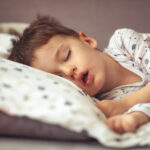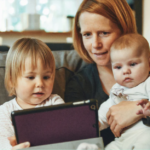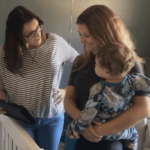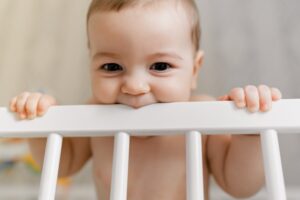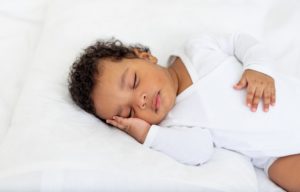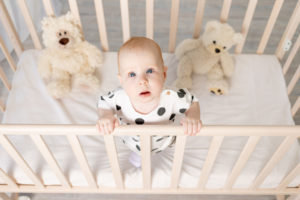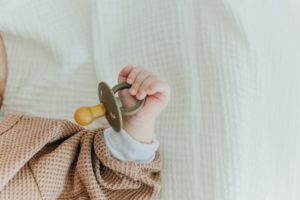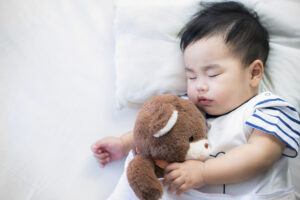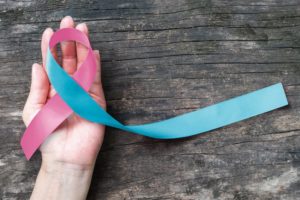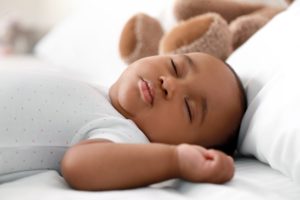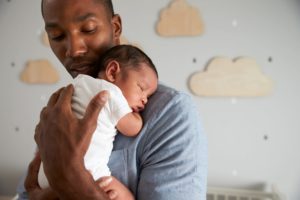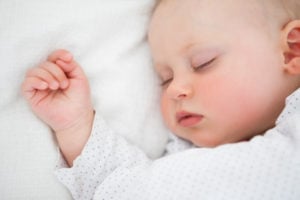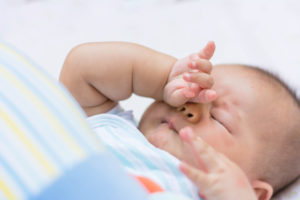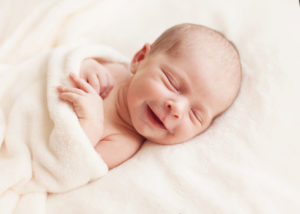When you buy through our links, we may earn a commission. Products or services may be offered by an affiliated entity. Learn more.
Babies and Head Banging at Night
Parents of infants often spend considerable time and attention promoting their child’s sleep. In this process, parents may be thrown off by a new behavior that arises during infancy: their child repetitively and rhythmically banging their head or rolling their body at bedtime or during the night.
Although head banging can be loud and may be unsettling for parents to see, it is typically benign. It’s very uncommon for babies to be hurt by head banging. In most cases, this behavior goes away on its own during the toddler years and is not usually a sign of any health or developmental problem.
What Is Head Banging?
Head banging is a repeated motion that happens around bedtime or during sleep. It can appear differently based on a child’s posture:
- When face down in bed, they lift their head and sometimes part of the upper torso and then slam themselves back down into the mattress.
- When sitting, they bang their head against the crib, a wall, or another nearby object.
Head banging continues with a consistent rhythm, happening every one to two seconds. It can go on for an extended period but typically lasts for 15 minutes or less. In many cases, head banging is accompanied by vocalizations such as a steady humming sound. When spoken to, a child may temporarily stop the behavior but will usually return to head banging shortly thereafter.
Most head banging in babies and children happens in the lead-up to sleep , but it can also occur while they are sleeping. It may happen before and during daytime naps as well.
It is believed that babies and children are not aware of head banging. When children who are old enough to talk are asked the next morning, they usually don’t have any recollection of head banging the night before.
How Is Head Banging Related to Body Rocking and Head Rolling?
Head banging isn’t the only type of repetitive movement that can occur before and during sleep. Examples of other rhythmic movements include:
- Body Rocking: A child may move their whole body back and forth while on their hands and knees or just move their torso if sitting down.
- Head Rolling: Usually occurring when a child is on their back, this is a frequent side-to-side head motion.
- Body or Leg Rolling: This is a side-to-side movement of the body or just the legs when lying on their back.
- Leg Banging: In this movement, which generally occurs while a child is on their back, the legs are lifted and then knocked back into the bed.
Head banging, body rocking, and head rolling are the most common of these rhythmic movements. Some children may exhibit more than one of these movements at the same time.
Body rocking often begins earlier in infancy, commonly starting at around six months of age, while head banging, on average, starts at about nine months.
Why Does Head Banging Happen in Babies and Infants?
It is unknown exactly why babies bang their heads or engage in other rhythmic movements before or during sleep. Existing research about these behaviors remains limited , but there are some theories for why head banging happens:
- It’s a means of self-soothing. Even though the movement looks anything but relaxing to parents, its rhythmic nature may help a child fall asleep.
- It’s a form of self-stimulation. Head banging and related actions may be a way of stimulating the vestibular system in the inner ear, which plays an important role in childhood development , helping to comprehend movement and obtain environmental awareness.
- It’s a response to anxiety. While evidence for this view is more limited, some researchers believe rhythmic movements are a basic way that very young children cope with anxiety.
Further research is needed in order to determine whether any of these hypotheses conclusively explain why head banging happens in infants and young children.
Help Your Baby Sleep Better With Pediatric Sleep Coaching
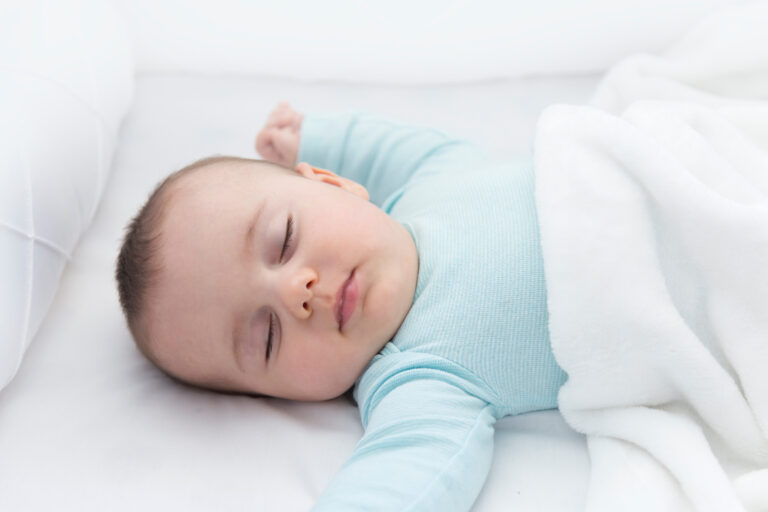
our partner at sleepdoctor.com
Learn More“Life-changing! My anxiety about my son’s sleeping habits were immediately reduced after talking to Sara. She went above and beyond to tailor a schedule to our goals, answer our questions, keep us on track, and check in to encourage us when we just thought we couldn’t do it anymore.”
Rachael B. – Verified Customer
How Common Is Head Banging?
Repetitive movements like head banging are quite common in infants; an estimated 59% of nine-month-olds engage in head banging, body rocking, head rolling, or a similar movement.
As children move into the toddler years, the prevalence of head banging declines. At 18 months, rhythmic movements are seen in 33% of children. By the age of five, the prevalence drops to just 5%.
Is Head Banging a Health Concern?
Head banging by babies is usually not a health concern. For most infants and young children, the rhythmic movements do not pose any problems for their sleep or development. While seeing or hearing head banging or body rolling can be worrying for parents, it is rarely a risk to their child.
The exception is Sleep Related Rhythmic Movement Disorder. This condition is diagnosed when head banging or other similar behaviors cause injury to a child, significantly disturb their sleep, or cause daytime impairment . Research has found that only 0.34% to 2.87% of infants and toddlers have this disorder. As this data demonstrates, the large majority of children who engage in rhythmic, repetitive behaviors do not have Sleep Related Rhythmic Movement Disorder.
Even children with this disorder are unlikely to inflict serious self-harm as long as basic safety precautions are in place. However, they do have more sleep disruptions , lower sleep quality, and more daytime problems like reduced concentration or memory.
Is Head Banging a Sign of a Bigger Health Problem?
It is uncommon for head banging to be an indicator of a bigger health problem. Though parents may worry that this activity is a sign of a developmental disorder or another issue, this is rarely the case. For most children, head banging is a benign and temporary phase with no implications for a child’s cognitive, physical, or emotional development.
In children with diagnosed Sleep Related Rhythmic Movement Disorder, research is inconclusive about whether there is a link to issues like anxiety disorder or attention-deficit/hyperactivity disorder (ADHD). No clear connection has been established to date, and only some, not all, children with a sleep movement disorder show signs of a mental health condition.
Some research indicates that Sleep Related Rhythmic Movement Disorder may have an association with obstructive sleep apnea (OSA), a condition of breathing lapses during sleep, or restless leg syndrome (RLS), which is marked by a strong urge to move the limbs. While all of these conditions can cause disrupted sleep, research so far has not demonstrated any consistent link between them.

When Should Parents Talk to a Doctor About Head Banging?
Head banging is rarely a medical concern, but parents should talk about it with their child’s doctor if:
- There are any signs of injury from head banging or other repetitive movements
- Their child isn’t getting enough sleep at night or shows signs of inattention, lack of concentration, or impaired thinking during the day
- The movements take place throughout the day and not just before or during sleep
- Head banging persists after a child is no longer a toddler
In most cases, a pediatrician will ask parents to maintain a diary of their child’s sleep including how frequently they have episodes of head banging. This may be sufficient to determine if a child has Sleep Related Rhythmic Movement Disorder, but if necessary, the doctor can order other tests to rule out the presence of other sleep disorders and arrive at a definitive diagnosis.
What Should Parents Do About Their Child’s Head Banging?
If a child’s rhythmic movements don’t affect their sleep or cause injury, parents usually don’t need to take any specific action. Over time, these behaviors normally go away on their own. If there are signs of injury of sleep disruption, though, parents should talk with their child’s doctor for guidance.
In general, because most head banging is benign, there’s no need for parents to intervene to try to stop these movements. Doing so may affect a child’s sleep, and it can also lead to frustration for parents since many children will quickly revert back to their rhythmic movements.
Parents who worry about their child’s head banging can follow basic safety measures to decrease the risk of injury. This means making sure that their crib or bed is well-built and meets national safety standards . Regularly checking for damage and making sure that the screws are tight can keep the crib stable with nightly use. In order to protect against sudden infant death syndrome (SIDS) , babies under 12 months of age should sleep on their back, on a firm mattress, and with no soft items in their crib.
If the noise of head banging or body rocking is bothersome for parents or other family members, the crib can be moved away from the wall to minimize reverberations. A white noise machine in the room with the child may help soothe them and block out sound disturbances that could wake them up. A baby monitor is a good way to keep an eye on nighttime activities without having to physically go to the bedroom to check on them.
Does Head Banging Happen in Adults?
Although very rare, Sleep Related Rhythmic Movement Disorder can persist into adolescence and adulthood.
Because it is uncommon, there is much that remains unknown about this disorder in adults. Studies have found that adults with Sleep Related Rhythmic Movement Disorder are more likely to have significant daytime symptoms. Familial patterns in which multiple close relatives have the disorder appear to be more common in adults.
Some studies noted that adults with Sleep Related Rhythmic Movement Disorder were more likely to have coexisting conditions like ADHD, mental health disorders, autism, or damage to the central nervous system. Other studies, though, have not identified the same associations. In addition, many people with abnormal behavior related to these other conditions exhibit repetitive motions throughout the day and not just before and during sleep.
Considerably more research will be necessary in order to understand what causes head banging to continue into adulthood as well as how and why Sleep Related Rhythmic Movement Disorder can be different in children and adults.

Still have questions? Ask our community!
Join our Sleep Care Community — a trusted hub of sleep health professionals, product specialists, and people just like you. Whether you need expert sleep advice for your insomnia or you’re searching for the perfect mattress, we’ve got you covered. Get personalized guidance from the experts who know sleep best.
References
12 Sources
-
Laganière, C., Gaudreau, H., Pokhvisneva, I., Atkinson, L., Meaney, M., & Pennestri, M. H. (2019). Maternal characteristics and behavioural/emotional problems in preschoolers: how they relate to sleep rhythmic movements at sleep onset. Journal of sleep research, 28(3), e12707.
https://onlinelibrary.wiley.com/doi/10.1111/jsr.12707 -
Chiaro, G., Maestri, M., Riccardi, S., Haba-Rubio, J., Miano, S., Bassetti, C. L., Heinzer, R. C., & Manconi, M. (2017). Sleep-Related Rhythmic Movement Disorder and Obstructive Sleep Apnea in Five Adult Patients. Journal of clinical sleep medicine : JCSM : official publication of the American Academy of Sleep Medicine, 13(10), 1213–1217.
https://www.ncbi.nlm.nih.gov/pmc/articles/PMC5612639/ -
Gwyther, A., Walters, A. S., & Hill, C. M. (2017). Rhythmic movement disorder in childhood: An integrative review. Sleep medicine reviews, 35, 62–75.
https://pubmed.ncbi.nlm.nih.gov/27884450/ -
Wiener-Vacher, S. R., Hamilton, D. A., & Wiener, S. I. (2013). Vestibular activity and cognitive development in children: perspectives. Frontiers in integrative neuroscience, 7, 92.
https://pubmed.ncbi.nlm.nih.gov/24376403/ -
Hayward-Koennecke, H. K., Werth, E., Valko, P. O., Baumann, C. R., & Poryazova, R. (2019). Sleep-Related Rhythmic Movement Disorder in Triplets: Evidence for Genetic Predisposition?. Journal of clinical sleep medicine : JCSM : official publication of the American Academy of Sleep Medicine, 15(1), 157–158.
https://pubmed.ncbi.nlm.nih.gov/30621834/ -
Gall, M., Kohn, B., Wiesmeyr, C., van Sluijs, R. M., Wilhelm, E., Rondei, Q., Jäger, L., Achermann, P., Landolt, H. P., Jenni, O. G., Riener, R., Garn, H., & Hill, C. M. (2019). A novel approach to assess sleep-related rhythmic movement disorder in children using automatic 3D analysis. Frontiers in Psychiatry, 10, 709.
https://pubmed.ncbi.nlm.nih.gov/31681030/ -
Gogo, E., van Sluijs, R. M., Cheung, T., Gaskell, C., Jones, L., Alwan, N. A., & Hill, C. M. (2019). Objectively confirmed prevalence of sleep-related rhythmic movement disorder in pre-school children. Sleep medicine, 53, 16–21.
https://linkinghub.elsevier.com/retrieve/pii/S138994571830697X -
Laganière, C., Pennestri, M. H., Rassu, A. L., Barateau, L., Chenini, S., Evangelista, E., Dauvilliers, Y., & Lopez, R. (2020). Disturbed nighttime sleep in children and adults with rhythmic movement disorder. Sleep, zsaa105. Advance online publication.
https://academic.oup.com/sleep/article/doi/10.1093/sleep/zsaa105/5847766 -
Mayer, G., Wilde-Frenz, J., & Kurella, B. (2007). Sleep related rhythmic movement disorder revisited. Journal of sleep research, 16(1), 110–116.
https://onlinelibrary.wiley.com/doi/10.1111/j.1365-2869.2007.00577.x -
U.S. Consumer Product Safety Commission. (n.d.). Safe Sleep – Cribs and Infant Products Information Center., Retrieved September 30, 2020, from
https://www.cpsc.gov/SafeSleep -
Eunice Kennedy Shriver National Institute of Child Health and Human Development (NICHD). (n.d.). Ways to Reduce The Risk Of SIDS And Other Sleep-Related Causes Of Infant Death., Retrieved September 30, 2020, from
https://safetosleep.nichd.nih.gov/safesleepbasics/risk/reduce -
Stepanova, I., Nevsimalova, S., & Hanusova, J. (2005). Rhythmic movement disorder in sleep persisting into childhood and adulthood. Sleep, 28(7), 851–857.
https://academic.oup.com/sleep/article-lookup/doi/10.1093/sleep/28.7.851


